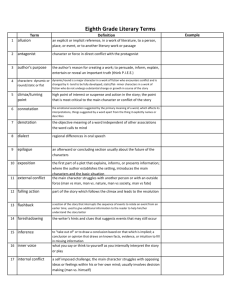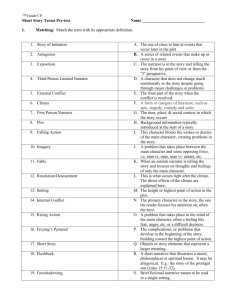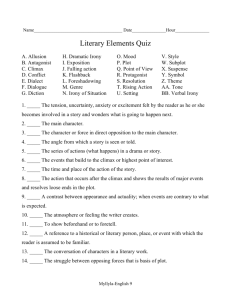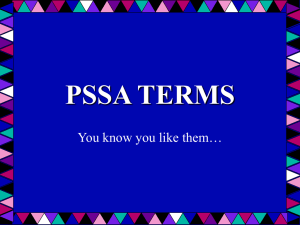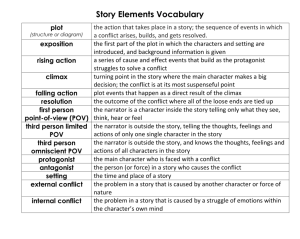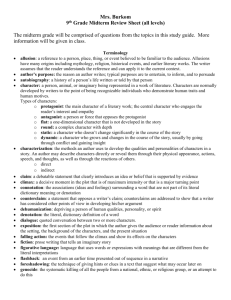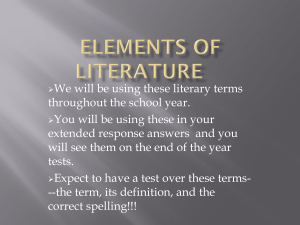Literary Terms – Short Story Unit
advertisement
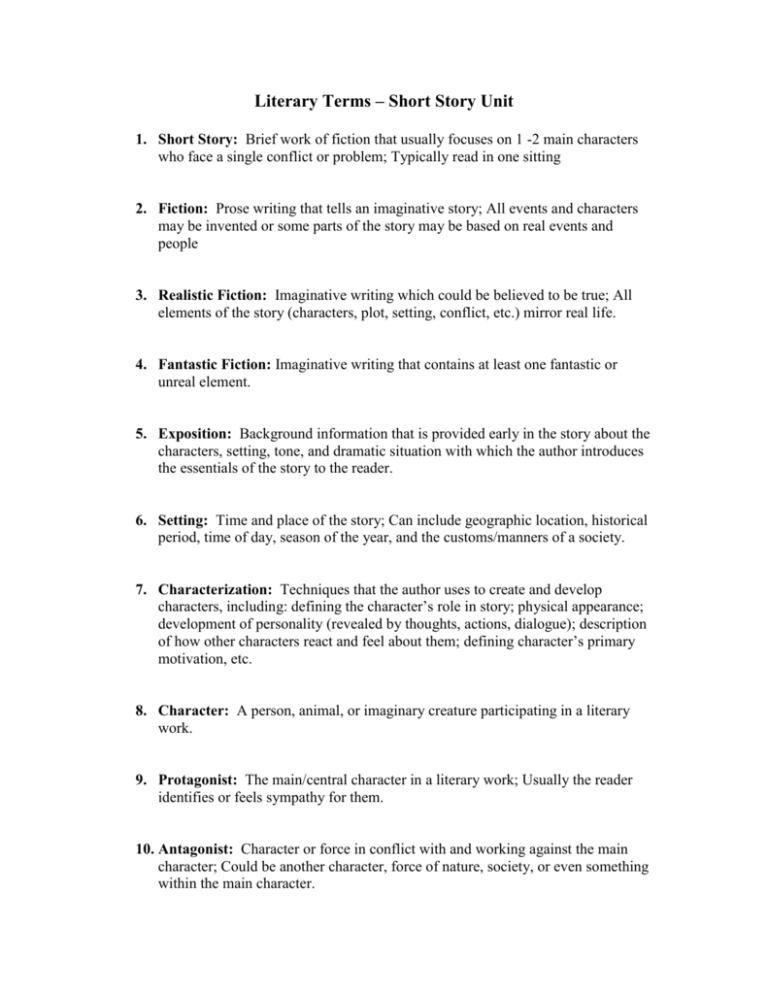
Literary Terms – Short Story Unit 1. Short Story: Brief work of fiction that usually focuses on 1 -2 main characters who face a single conflict or problem; Typically read in one sitting 2. Fiction: Prose writing that tells an imaginative story; All events and characters may be invented or some parts of the story may be based on real events and people 3. Realistic Fiction: Imaginative writing which could be believed to be true; All elements of the story (characters, plot, setting, conflict, etc.) mirror real life. 4. Fantastic Fiction: Imaginative writing that contains at least one fantastic or unreal element. 5. Exposition: Background information that is provided early in the story about the characters, setting, tone, and dramatic situation with which the author introduces the essentials of the story to the reader. 6. Setting: Time and place of the story; Can include geographic location, historical period, time of day, season of the year, and the customs/manners of a society. 7. Characterization: Techniques that the author uses to create and develop characters, including: defining the character’s role in story; physical appearance; development of personality (revealed by thoughts, actions, dialogue); description of how other characters react and feel about them; defining character’s primary motivation, etc. 8. Character: A person, animal, or imaginary creature participating in a literary work. 9. Protagonist: The main/central character in a literary work; Usually the reader identifies or feels sympathy for them. 10. Antagonist: Character or force in conflict with and working against the main character; Could be another character, force of nature, society, or even something within the main character. 11. Narrator: Person telling the story (different than the author – who writes the story) 12. Point of View: The perspective in which the story is told. 13. First Person Point of View: Used when the story is revealed by a narrator who participates in the story as a character; personal pronouns such as I, me, and us would be used. 14. Third Person Point of View: Used when the story is revealed by a narrator who does not participate as a character within the story, but rather by an “outside” voice; Demonstrative pronouns such as he, she, it, and they would be used. 15. Omniscient Point of View: Used when the narrator is “outside” of the story and presents the thoughts and feelings of more than one character. 16. Limited Point of View: Used when the narrator tells the story from the viewpoint (thoughts/feelings) of only one character 17. Dialogue: Conversation between 2 or more characters; Words that the characters speak aloud; Used to bring characters to life and to give readers insights into the character’s thoughts/feelings; Usually set off with quotation marks. 18. Dialect: Form of spoken language that would be specific to a particular geographic area or by a certain group of people; May feature specific pronunciations, spelling, vocabulary, and grammar. (Urban, Southern, Bostonian) 19. Jargon: Specialized vocabulary for a particular group of people that would not necessarily be well known to people outside of that group. (golfer’s – par, bogie, birdie) 20. Plot: The series of related actions which make up the work of fiction; Typically a well-developed plot will begin with an exposition, and a defined conflict, climax, and resolution will follow. 21. Conflict: The struggle between opposing forces which make up the general problem of the story; Usually the source of tension and drama of the story. 22. Internal Conflict: Problem or struggle exists within the protagonist 23. External Conflict: Problem or struggle exists between the protagonist and another character or force. 24. Rising Action: Refers to events which move the plot forward, building towards the climax; Usually involves several complications and the conflict. 25. Climax: The turning point and the moment of greatest suspense or maximum interest in the story; Usually occurs near the end of the story after the conflict is fully understood and the reader identifies with the character(s). 26. Resolution/Falling Action/Denouement: Outcome of the plot and the way in which the author ends/solves the conflict; Usually occurs after the climax. 27. Theme: Central idea or meaningful message presented in a literary work; Usually about life or human nature; Often the message needs to be inferred (conclusion reached by examining lessons learned by the main character or meaningful experiences of the main character that can be applied to life or to all people). 28. Tone: Expresses the author’s attitude toward the characters or subject matter of the literary work. 29. Mood: Intentional atmosphere created in a literary work that provokes specific feelings or an overall feeling in a reader. 30. Foreshadowing: Actions or clues provided to the reader that hints or suggests future events in the story; Creates suspense while preparing the reader for future happenings. 31. Flashback: Sudden shifting backwards in time (interruption to the story’s timeline) to relay events that occurred at an earlier time; usually done to provide background information needed to better understand a character or situation unfolding in the story. 32. Hook: An early event in the story that grabs the reader’s attention to insure interest in reading the rest of the story. 33. Complication: A minor problem(s) presented in the story in addition to the conflict. 34. Symbolism: Something that is meaningful in its own literal sense, yet standing for something else at the same time; A person, place, object, or action that stands for something beyond itself. (dove – peace) 35. Irony: Contrast between what is expected to happen and what actually does exist of happen; Usually involves something unexpected and humorous. 36. Contrast: Process of pointing out differences between two things 37. Allusion: Reference in a literary work to something famous or well known; such as another character, a person, a place, an event, a piece of art. 38. Paradox: A statement that contains an apparent contradiction, yet also seems to be true at the same time. (“The more a man learns, the more he realizes how little he knows.”) 39. Motivation: Values, desires, and/or beliefs that cause a character to act the way that they do; Reasons why a character thinks, behaves, and feels a certain way. 40. Suspense: Curiosity aroused in a reader; Feelings of growing tension and/or excitement; Usually created by raising questions about what might happen.
